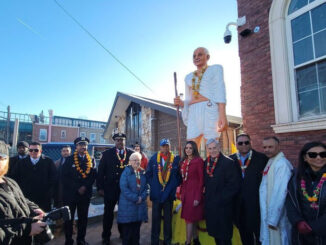
WASHINGTON (TIP): The northeastern US shivered amid heavy snowfall and far below average temperatures on January 23 in a storm that grounded thousands of flights and triggered traffic chaos.
The nasty weather with its bone-chilling gusts and heavy snow stretched from Washington to New England. The Midwest was hit hard, too. Taking into account the wind chill factor, the temperature in Chicago plummeted to minus 20 Fahrenheit (-28 Celsius), the Chicago Tribune said.
In the nation’s largest city, the Tuesday evening commute home in New York was a mess and the city was expected to get as many as 14 inches (35 cm) of snow by Wednesday morning. “It’s horrible. Snow is cute for only a little bit,” Mary Catherine Hughes, standing by a subway stop with an umbrella rendered useless in fierce wind, told The New York Times. The city’s new mayor Bill de Blasio urged people to stay home say road crews could clear streets.

Downtown Washington fell eerily silent after the federal government, seeing the swift-moving storm approaching, closed its doors and told civil servants — who already had the day off on Monday for the Martin Luther King holiday — to stay home on Tuesday. On January 23, federal agencies were to open two hours late. Employees could also take unscheduled leave, and those that can were allowed to work from home. The nation’s capital is famous for cowering in the face of even a few flakes but Tuesday’s storm seemed to justify a shutdown.
Many offices and schools followed suit, as 20 mile (32 kilometer) per hour winds whipped through the US capital’s unusually quiet streets. Most area schools, in the city and neighboring Maryland and Virginia, were to remain closed again on January 23. Washington’s Metro public transit system reported Tuesday half as many riders as on a typical weekday. Business was so slow that many restaurants used Twitter to woo customers with bargain-priced drinks while others offered customers 2-for-1 deals.
In Philadelphia, as of early evening Tuesday, the official total at Philadelphia International Airport was 11 inches of snow, a record for the day January 21. The “storm system will strengthen overnight in the Atlantic waters off the East Coast, spreading heavy snow and strong wind into coastal sections of New England and the Northeast,” the National Weather Service said. Temperatures across the eastern part of the country Wednesday will be 10 to 25 degrees below average, amid bitter wind chills, it warned.
Flight Aware, a website that monitors air traffic in real time, said nearly 3,000 flights into, out of or within the United States had been cancelled on Tuesday. The lion’s share of affected flights involved busy airports in the New York, Philadelphia and Washington areas. Seven inches (18 centimeters) of snow had fallen at Washington’s Dulles International Airport while some 11 inches were reported at the Philadelphia International Airport, according to AccuWeather, a private forecasting service. Accumulations of six to 12 inches were expected over the mid-Atlantic to southeastern New England, it said.
National rail company Amtrak said it would operate “a modified schedule” Wednesday on its Northeast Corridor line between Washington and Boston, as well as on two other routes in the hard-hit region. States of emergency were declared there, as well as in New Jersey and Delaware, according to the media. More than 1,700 plows were to be mobilized in New York on January 22 night to clear up to 10 inches of snow, it reported. Across the Hudson River, New Jersey went ahead with its mid-day inauguration ceremony for re-elected governor Chris Christie, who is battling allegations he used his office to bully political foes.
But an evening gala on historic Ellis Island in New York Harbor to mark the start of his new term in office was scrapped due to the storm. Schools across the Northeast either closed for the day or told parents to expect their youngsters to be dismissed from class earlier than usual. Closures in many areas were extended through on January 24. Meanwhile, courthouses called off proceedings in the afternoon. What the National Weather Service called a “fast moving but potent” snowstorm had earlier dumped seven inches of snow on airports in the Chicago area, before temperatures fell to the freezing level.





Be the first to comment